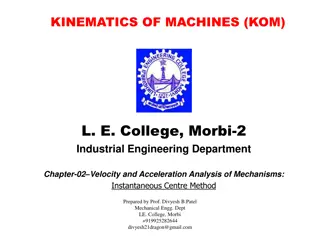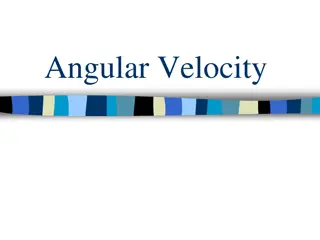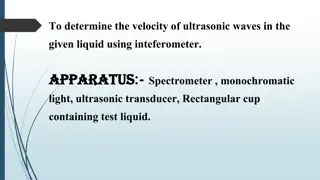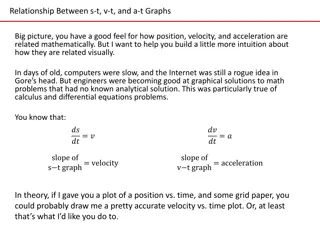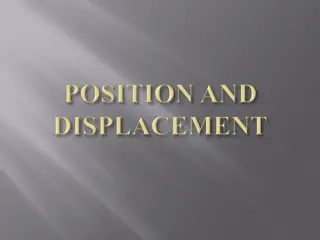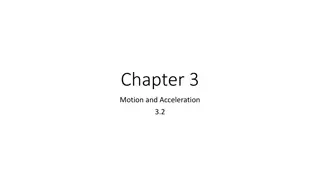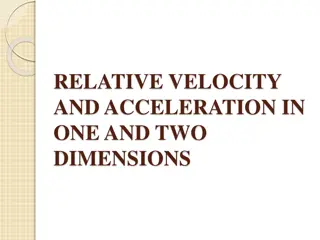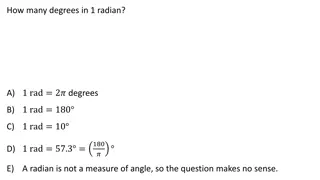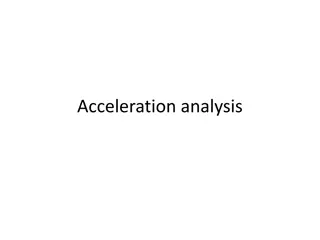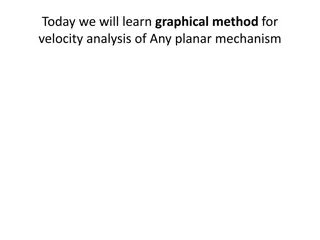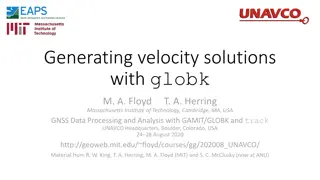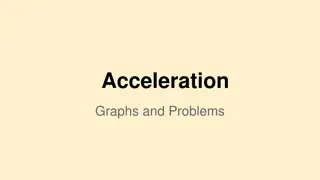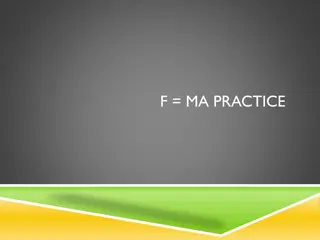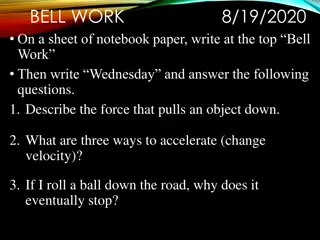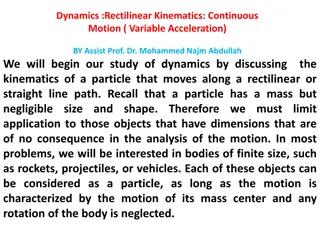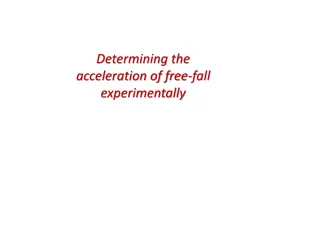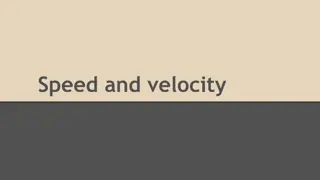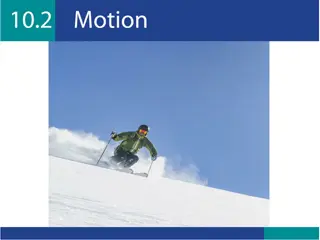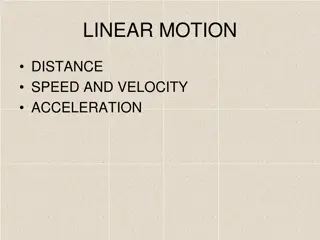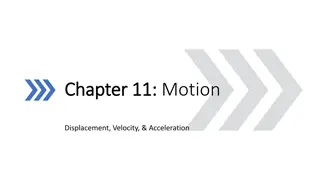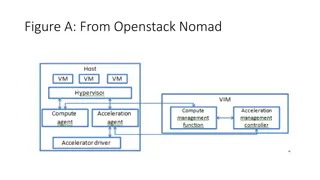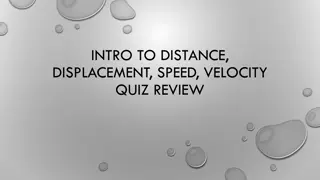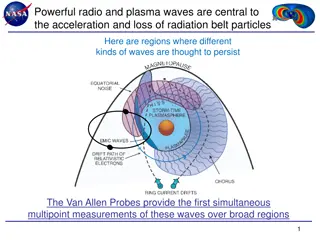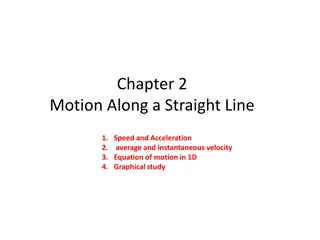Kinematics of Machines: Instantaneous Center Method for Velocity and Acceleration Analysis
Explore the method of locating instantaneous centers in mechanisms to analyze velocity and acceleration. The content covers examples of pin-jointed four-bar mechanisms and slider-crank mechanisms, providing dimensions and angular velocities calculations. Prof. Divyesh B. Patel from L.E. College, Mor
0 views • 13 slides
Understanding Acceleration in Physics
Acceleration is the rate at which velocity changes, encompassing both increases and decreases in speed. In physics, acceleration is defined as the rate of change in velocity, making it a vector quantity due to its directional nature. This article explores the concept of acceleration, including examp
0 views • 15 slides
Understanding Velocity vs. Speed in Physics
Velocity and speed are fundamental concepts in physics that describe how fast an object is moving and in what direction. While speed is a scalar quantity representing the rate of motion, velocity is a vector quantity that includes both speed and direction. Constant velocity implies steady speed and
0 views • 8 slides
Understanding Free Fall and Acceleration in Gravity
Objects in free fall experience acceleration due to gravity, increasing their speed by 10 meters per second each second. The acceleration is denoted by 'g,' with an average value of around 10 m/s². When falling from rest, the speed of an object can be calculated using the formula v = gt. Likewise,
1 views • 21 slides
Understanding Rotational Motion: Angular Velocity and Acceleration
Explore the concepts of angular velocity, radians, and rotational motion in this educational content. Learn about the relationship between angular and linear velocity, angular acceleration, tangential acceleration, and centripetal acceleration through practical examples. Enhance your understanding o
2 views • 17 slides
Determining Ultrasonic Wave Velocity in Liquid Using Interferometer
An ultrasonic interferometer apparatus is used to determine the velocity of ultrasonic waves in a liquid medium by creating longitudinal stationary waves and utilizing the principles of diffraction. The experiment involves passing monochromatic light through the liquid, creating an acoustic grating,
0 views • 16 slides
Understanding the Relationship Between Position, Velocity, and Acceleration Graphs
Gain intuition on how position, velocity, and acceleration are visually related through s-t, v-t, and a-t graphs. Discover how to interpret and draw accurate velocity vs. time plots based on position vs. time data. Learn the significance of comparing these charts and how they can be useful in variou
0 views • 20 slides
Understanding Position, Motion, and Displacement in Physics
Position in physics refers to a place or location within a coordinate system, crucial for describing an object's motion through time. It involves factors like observer frame, coordinates, and whether the object is at rest or in motion. Motion is defined by an object's position, speed, direction, and
0 views • 15 slides
Understanding Velocity: The Key to Motion
Velocity is the speed and direction at which an object moves, indicating both its position and rapidity. It is crucial for measuring the rate of change of an object's position over time and differentiates from speed as a vector quantity. This comprehensive guide delves into the concepts of velocity,
2 views • 33 slides
Understanding Motion Under Constant Acceleration
Constant acceleration refers to motion where the speed increases by the same amount each second. It is exemplified in scenarios like free fall due to gravity, where objects experience a consistent acceleration of approximately 10 meters per second squared. This type of motion plays a significant rol
0 views • 11 slides
Understanding Speed vs. Time Graphs: Analyzing Acceleration and Motion
Explore the concept of speed vs. time graphs and learn how to recognize acceleration, interpret speed, analyze motion, and calculate acceleration from the slope of the graph. Discover the characteristics of graphs showing constant acceleration, varying acceleration, and deceleration. Engage in drawi
0 views • 19 slides
Understanding Acceleration in Motion: Concepts and Examples
Delve into the world of acceleration in motion with this informative content. Learn how acceleration is defined, its relationship with velocity, and the different types of acceleration - positive, negative, and zero. Examples like a car at a stoplight, a bouncing ball, and a jet airliner on a runway
0 views • 8 slides
Understanding Distance, Speed, and Acceleration in Physics
Explore the concepts of distance, speed, and acceleration in physics with practical examples and calculations. Learn how to calculate speed, interpret distance-time graphs, differentiate between speed and velocity, and understand acceleration through scenarios involving various moving objects. Gain
9 views • 12 slides
Understanding Relative Velocity and Acceleration in Physics
Relative velocity is defined as the velocity of an object in the rest frame of another object, and it can be negative depending on the difference in velocities. The need for using relative velocity lies in determining if an object is at rest or moving. The formula for relative velocity involves the
1 views • 25 slides
Physics Concepts: Angular Velocity, Radians, and Acceleration Explained
Understand essential physics concepts such as angular velocity in radians, comparison of angular velocities, tangential velocity, magnitudes of velocities, and angular acceleration as applied to various scenarios like rotating wheels, clock hands, and spinning objects. Dive into the relationships be
1 views • 31 slides
Physics Practice Problems: Wheels, Rotations, and Acceleration
Explore a series of physics practice problems related to wheels, rotations, angular velocity, tangential velocity, and acceleration. Dive into scenarios involving bicycles, skateboards, hard drives, and cars to test your understanding of these concepts. From calculating linear distances traveled to
0 views • 36 slides
Acceleration Analysis of Slider Crank Mechanism
In this analysis, we calculate the acceleration of the slider at point B, acceleration of point E, and the angular acceleration of the link AB in a slider crank mechanism. The steps involve drawing configuration, velocity, and acceleration diagrams with suitable scales to determine the necessary par
0 views • 12 slides
Understanding Relative Velocity of Bodies in Motion
The content explains concepts related to relative velocity of moving bodies, including diagrams illustrating velocity relationships, application of laws of parallelogram and triangle, analysis of motion in rigid links, and calculation of rubbing velocity at pin joints in mechanisms. It covers scenar
0 views • 23 slides
Graphical Method for Velocity Analysis of Planar Mechanisms
Learn about the graphical method for velocity analysis of planar mechanisms through practice problems involving slider-crank mechanisms and link velocities. Understand how to calculate slider velocity, point velocity, and angular velocities using the given dimensions and rotational speeds. Visualize
0 views • 6 slides
Measurement of Flow Velocity on Frozen and Non-Frozen Slopes of Black Soil Using Leading Edge Method
This study presented a detailed methodology for measuring flow velocity on frozen and non-frozen slopes of black soil, focusing on the Leading Edge method. The significance of shallow water flow velocity in soil erosion processes was emphasized. Various methods for measuring flow velocity were compa
0 views • 23 slides
Understanding Acceleration and Gravity in Physics
Explore the concepts of acceleration and gravity in physics through engaging images and key points. Learn about mass, weight, Newton's Law of Gravitational Attraction, and the acceleration due to Earth's gravity. Discover how all objects fall at the same rate regardless of mass and what factors can
3 views • 31 slides
Understanding Vertical Motion and Gravity in Kinematics
Explore the principles of vertical motion and gravity in kinematics through scenarios involving throwing objects, free-fall motion, and calculating heights. Learn how to model vertical motion with acceleration due to gravity, find maximum heights of thrown objects, solve extended problems, and under
2 views • 12 slides
Strategies for Generating Velocity Solutions with GLOBK
Basics of velocity solutions, setup strategies, and data cleaning methods for optimizing GLOBK solutions to generate position, velocity, offset, and postseismic parameter estimates. The aim is to combine years of data, make critical decisions on data treatment, and ensure accuracy in the process noi
0 views • 22 slides
Understanding Acceleration in Physics
Explore the concept of acceleration through real-world scenarios involving moving objects and graphs. Learn how to determine the direction of acceleration based on the velocity changes of cars, divers, bungee jumpers, and more. Delve into examples of calculating average acceleration and final veloci
0 views • 11 slides
Effect of Weighted Sled Towing and Weighted Vest on Sprinter Acceleration Performance
Short distance running involves crucial phases affecting sprint performance, with acceleration being particularly important. Training methods like weighted sled towing and weighted vest usage have been found effective in enhancing sprint acceleration. This study investigated the impact of these meth
0 views • 8 slides
Mechanics Practice Problems with Force and Acceleration
Solve practice problems involving force, mass, and acceleration in physics. Calculate net force accelerating a bicycle, mass of the Space Shuttle based on thrust and acceleration, acceleration of a runner given force and mass, and acceleration of a car with a known force and mass.
0 views • 5 slides
Physics Concepts and Practice Questions
Explore the fundamental concepts of physics such as forces, acceleration, and velocity through a series of practice questions and explanations. Understand how gravity pulls objects down, ways to accelerate, and the forces at play in everyday scenarios. Practice calculating acceleration and learn how
0 views • 13 slides
Understanding Kinematics: Motion Description and Homework Tasks
Dive into the world of kinematics with a focus on describing motion, understanding velocity and acceleration, and solving homework tasks related to chapter 2. Explore the concepts of position, velocity, and acceleration graphs, and grasp the special case of motion with constant acceleration. The war
0 views • 53 slides
Dynamics: Rectilinear Kinematics - Continuous Motion with Variable Acceleration
Begin your study of dynamics by understanding the kinematics of a particle moving along a straight path. Learn about position, velocity, acceleration, displacement, and how to differentiate between them. Explore the concept of speed and average speed as essential components of rectilinear motion.
0 views • 11 slides
Understanding Motion: Speed, Velocity, and Acceleration
Motion is the change in position of an object relative to a reference point. Speed is the distance traveled divided by the time interval, while velocity includes direction. Acceleration refers to the rate of change of velocity. Different concepts and scenarios related to motion, speed, velocity, and
0 views • 16 slides
Experimental Determination of Acceleration of Free Fall
Experimentally determining the acceleration of free fall by analyzing the motion of an apple and a feather falling in a vacuum. By scaling and analyzing the data, the acceleration is calculated to be approximately 9.82 m/s^2, indicating a constant acceleration due to gravity.
0 views • 13 slides
Understanding Speed and Velocity in Physics
Speed and velocity are fundamental concepts in physics. Speed is a scalar quantity that can be average or instantaneous, while velocity is a vector quantity that includes direction. Equations such as v=d/t help calculate these values. Average speed and average velocity are important in determining t
1 views • 10 slides
Understanding Kinematics Graphs in Physics
Explore the concepts of kinematics graphs through diagrams and descriptions. Learn to interpret distance-time, velocity-time, and speed-time graphs. Understand key parameters such as displacement, initial velocity, final velocity, constant acceleration, and time spent on different parts of a journey
0 views • 33 slides
Understanding Motion in Physics
Explore the concepts of speed, velocity, and acceleration in physics, learn how to interpret distance-time and velocity-time graphs, and practice calculating the speed and acceleration of objects. Engage in experiments to calculate average speeds and write reports detailing procedures, variables, da
0 views • 77 slides
Understanding Linear Motion: Distance, Speed, Velocity, and Acceleration
Explore the concepts of linear motion in physics, including distance, speed, velocity, and acceleration. Learn how to calculate average speed, interpret graphs, and convert units. Engage in practical experiments to investigate everyday objects' motion. Enhance your understanding through illustration
0 views • 57 slides
Understanding Motion: Displacement, Velocity, and Acceleration
Explore the fundamental concepts of motion, including displacement, velocity, and acceleration. Learn about reference points, distance versus displacement, speed versus velocity, and how to calculate average speed and acceleration. Dive into examples illustrating these concepts in real-world scenari
0 views • 24 slides
Acceleration Management Architectures in OpenStack Nomad and DPACC
The figures depict the architecture of Software Acceleration Layer (SAL), Acceleration Management Layer (AML), and other components in OpenStack Nomad and DPACC. They illustrate the interaction between Software Routing Layer (SRL), General Drivers (g-drivers), Hardware I/O Interface (hio), and more
0 views • 4 slides
Motion and Velocity Concepts Illustrated Quiz Review
Explore concepts of distance, speed, displacement, and velocity through examples of a moving truck's position, Julie's journey to meet her friends, and calculations of velocity for trips from Pittsburgh to Philadelphia and Hong Kong to Los Angeles. Understand the differences between speed and veloci
0 views • 8 slides
Unveiling the Role of Radio and Plasma Waves in Particle Acceleration
Radio and plasma waves play a crucial role in the acceleration and loss of radiation belt particles. The Van Allen Probes provide groundbreaking multipoint measurements of these waves in various regions, shedding light on phenomena such as chorus waves and resonant wave acceleration. Strong correlat
0 views • 8 slides
Understanding Motion Along a Straight Line
Exploring the concepts of speed, acceleration, velocity, displacement, and distance in one-dimensional motion. Topics include average and instantaneous velocity, equation of motion, graphical analysis, position measurement, and the differences between distance and displacement. Dive into average spe
0 views • 47 slides
